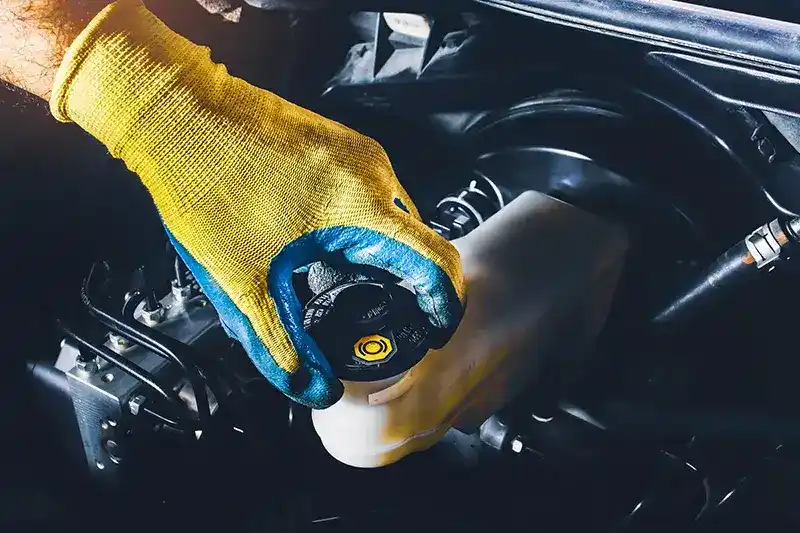How to check brake fluid
09 Aug 2024

It’s probably not something you ever think about, but every time your car comes to a safe stop, there are many moving parts making it happen. Brake fluid ensures these components always run smoothly. It also transfers force from your foot on the pedal to the system that stops the wheels.
Knowing how to check brake fluid and regularly doing so can make you drive safer, making it an essential task to add to your regular car maintenance routine. Just like checking your engine oil, it should be done as frequently as your owner’s car manual recommends - and certainly before a long drive.
In this article, we’ll find out exactly what brake fluid is, why it’s so important, and go over some simple, step-by-step instructions to help you check and top up your brake fluid at home.
What is brake fluid?
Brake fluid is a hydraulic fluid used in most vehicles with a hydraulic braking system, such as cars, motorcycles, and trucks. It allows a small action (such as putting your foot down on a pedal or squeezing a lever), to result in a force strong enough to halt motion entirely.
How does brake fluid work?
When you apply pressure to your brake pedal, the pistons inside the master cylinder in your engine compress, creating pressurised brake fluid. This pressurised fluid then travels along the brake lines, amplifying the force of your foot hitting the pedal. In turn, the pressurised fluid causes the brake pads to squeeze on the braking system and bring them to a halt.
In addition to playing a major role in the entire braking function of your vehicle, brake fluid also acts as a lubricant to keep the other components operating smoothly and prevent corrosion. Put simply, without brake fluid, your car would fail to stop when required.
Just like your vehicle's other essential safety features, brake fluid should be regularly checked and topped up as necessary. This can easily be done at home. This is because old brake fluid can become contaminated, absorb moisture or develop air bubbles, reducing the system’s effectiveness.
Changing brake fluid is a much more complicated task that requires the expertise of a trained professional. It is often performed during an annual vehicle service, but you should book an appointment at your local garage if you notice your brakes losing their sensitivity, or see a warning light relating to your braking system.
Where does brake fluid go?
In a standard vehicle, brake fluid is filled in a translucent container located in the engine compartment. This can usually be found under the bonnet (or hood), on the driver’s side of the vehicle. Check your vehicle handbook if you’re not sure.
You should see a plastic reservoir on top, which may even be labelled with the words ‘brake fluid’ or have a specific icon (typically a yellow circle or an octagon). In most cars, there should be a full and minimum line allowing you to check the fluid level from the outside.
How to check brake fluid?
We recommend checking your brake fluid in line with your car’s owner’s manual, to maintain your vehicle’s optimum safety and performance standards. Checking your brake fluid only takes a few minutes:
- Take your vehicle for a short drive, braking multiple times to ensure the brake system is filled.
- Park on a flat surface, where it is safe to do so, to get an accurate reading.
- Locate the brake fluid reservoir (see the above section on ‘where does brake fluid go’).
- Brake fluid has a darker colour which can be seen through the white reservoir. There should be a minimum and full line allowing you to check whether your brake fluid needs topping up or not.
What brake fluid do I need?
There are several different types of brake fluid, and the most common ones are known by their DOT specification. The type best suited for your vehicle will be listed in your owner’s manual, and may also be inscribed on the cap of the brake fluid reservoir.
The most common types are DOT3, DOT4, and DOT5.1. Typically, brake fluids with a higher number have higher boiling points for performance driving.
How to top up brake fluid?
If, after checking your brake fluid, you find that you are running low or reaching the minimum line, it’s time to top up.
- Purchase the right brake fluid for your vehicle (see above).
- Park on a flat surface.
- Remove the reservoir cap and use a funnel to pour in the fluid until it reaches the ‘full’ line.
- Re-attach the reservoir cap securely.
As you can see, checking and topping up your brake fluid is a simple task that can make a big difference in keeping your car running at its best.
Adding this five-minute check to your regular car maintenance routine is a great way to prevent unexpected faults and stay safe on the roads.

